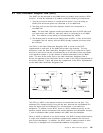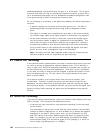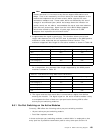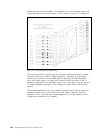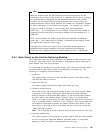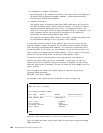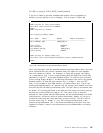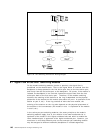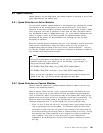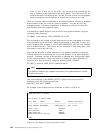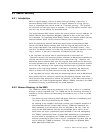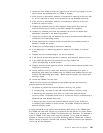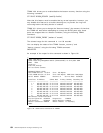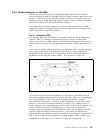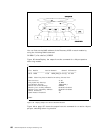
8.8 Speed Detection
Speed detection on the 8260 token-ring media modules is achieved in one of two
ways depending on the module type.
8.8.1 Speed Detection on Active Modules
For the active modules, speed detection is accomplished by counting the number
of transitions in the incoming data over a set period of time. If the rate of
transition is less than 4.5 MHz the station would only be allowed to enter 4 Mbps
token-rings and if the rate of transition is more than 4.5 MHz, the station would
only be allowed to enter 16 Mbps token-rings. So, if the module detects that the
station is trying to insert at the wrong speed, the speed mismatch will be
detected and the station will be prevented from inserting into the ring and
disrupting its operation.
When an incorrect speed is detected, the port is not allowed to unwrap (note that
under normal circumstances, when the station enters the ring, the port is in
wrapped state) and the status of the port is set to ″speed mismatch″. The port
will then be checked again when a transition of phantom is detected or when the
user disables and then enables the port.
Note
During the configuration of the 8260, you will set the ring speed for the
networks (token-ring-1 thru token-ring-10 and isolated_1 thru isolated_11)
using the following DMM command:
SET NETWORK TOKEN_RING token_ring_n RING_SPEED {4mbps|16mbps}
SET NETWORK TOKEN_RING isolated_n {slot} RING_SPEED {4mbps|16mbps}
Once, you set the ring speed, any port attached to that ring will assume the
speed of the ring. You do not set the ring-speed for each port.
8.8.2 Speed Detection on Passive Modules
Passive modules implement a software-based method to detect incorrect ring
speed on the attaching stations.
When a station inserts into the ring on a passive module, the module will first
wrap all the other ports on the module and also the module off the backplane.
Then, the Recovery ASIC in the module sends an All-Station MAC frame (at the
speed of the ring to which this port is assigned) on the newly inserted port. The
ASIC will wait for this MAC frame to be returned and it will inspect the ″A″
(address-recognized) and ″C″ (frame-copied) bits on the received frame.
•
If the ″A″ and ″C″ bits are set to B′1′ the station which just inserted into the
ring is operating at the correct speed. The Recovery ASIC will then allow
the station to insert into the ring and will also unwrap all the other ports on
the module allowing the existing users to resume access to the ring. During
this process, the existing stations on the module are unable to access the
ring. However, since this is a very short time, no user sessions are
expected to be terminated as a result of this temporary inability to access
the ring.
Chapter 8. 8260 Token-Ring Support 149



